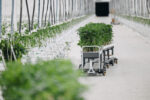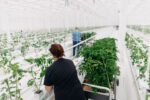A viable path to increased self-sufficiency
In a time when global supply chains are under strain and conflict and climate change pressure the food system Regenergy Frövi offers a path towards more resilient food production. At this 10-hectare greenhouse, waste heat from a paper mill replaces fossil fuels, making it possible to grow fresh tomatoes in Sweden with a fraction of the emissions of conventional greenhouses.
To measure the true impact of this project, a Life Cycle Assessment (LCA) and Life-cycle costing (LCC) comparing the greenhouse in Frövi to a conventional Dutch greenhouse has been done, assuming operation is as expected over a 30-year lifespan.The results? Proof of a food production system that is both more sustainable and economically competitive.
The Frövi greenhouse is fully operational, producing thousands of tons of fresh tomatoes and reducing Sweden’s dependence on carbon-intensive imports.
*This equals annual 430 tCO2eq avoided per MEUR invested
Further reading: The capex costs of reaching the Paris goals | Robeco Global.
- 83 %
global warming impact
(kg CO2-eq/kg tomatoes)
- 87 %
fossil fuels use
13kg*
Avoided CO₂-eq per invested € over 30 years project lifespan
*This equals annual 430 tCO2eq avoided per MEUR invested
Further reading: The capex costs of reaching the Paris goals | Robeco Global.
How is this possible?
The Frövi greenhouse runs on 100% hydropower and industrial waste heat, cutting both energy costs and climate impact.
By harvesting rainwater, recycling process water, and fine-tuning irrigation to deliver just the right amount of moisture to every plant keeps water usage to a minimum.
With energy being one of the main driver of operational costs, especially with the need for artificial grow light in the winter, cheaper energy prices in Sweden keeps the cost down.
Greenhouses heated with industrial waste heat can boost vegetable production in Sweden and other parts of the northern world. Moore local food production reduces imports
The LCA and LCC was completed by CIRCE in the EU’s Horizon 2020 project CORALIS, where Regenergy Frövi is a lighthouse demonstrator for industrial symbiosis.

The scope of this LCA covers the project from cradle-to-gate. This includes assessment of environmental impacts from the extraction of raw materials (cradle), through construction of the facility to the point where the product leaves the production facility (gate). The studies compare the Frövi waste heat greenhouse with a BAU Netherlands greenhouse and assumed that operation is as expected over a 30-year lifespan.

The demand for this kind of circular infrastructure is rising, driven by regulatory shifts, climate change, and consumer preference for local, low-impact food.
Our Projects

Scientific paper based on the Frövi LCA & LCC
Environmental and economic benefits of waste heat recovery as a symbiotic scenario in Sweden.
This paper uses Life Cycle Assessment and Life Cycle Costing to evaluate the environmental and economic performance of the greenhouse in Frövi, Sweden. It compares this symbiotic model to several conventional scenarios to explore how circular resource use can improve sustainability in food production.





